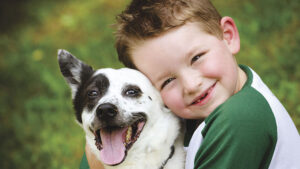It’s important to learn to identify early signs that your dog is stressed, and advocate for them by removing them from the situation before things escalate. Early signs of stress include things most people wouldn’t think of, including yawning, licking their lips, turning their face or body away from stressors, panting, or cowering. Even before these things occur, some owners will notice a worried or tense look on their dog’s face, with a furrowed brow. The dog’s body will go from loose and wiggly to still and stiff. If you have kids coming over to the house, it’s especially important to recognize these signs in order to keep everyone safe – both your kids and your dog!
Don’t just tell your kids and their friends what to do and what not to do around your dog, get them to brainstorm together! What things might frighten a dog? If they come up with the ideas on their own, they are more likely to retain the information.
Recently at one of my kids clinics, I had the students, ages 5-9, brainstorm things kids shouldn’t do around dogs. The list includes: slapping, wrestling, screaming, sudden movements, throwing, lying on the dog, riding the dog, getting in his face, stomping and growling. I was really pleased with the things they came up with. A week or so later, I overheard my own son – who had participated in the clinic – tell one of his friends that they should be quieter around their dog because loud sounds can be frightening. Proud mom moment right there!
Aside from teaching children what not to do around dogs, we need to teach them what TO do! This includes teaching your kids how to read body language (see www.doggonesafe.com and www.gooddoginabox.com for help, or join us for one of our kids clinics). It also includes teaching them ways that most dogs enjoy being petted. Like I said in a previous article, teach your kids “1, 2, 3, and see.” If the dog chooses to come to them on his own, they can pet him under the chest or on the side of the neck for up to three seconds. If the dog backs away or shows any of the stress signals mentioned earlier, he doesn’t want to be petted. If he leans into the petting, smiles, and has a loose, happy body, he probably enjoys it!
Not only is there a right way to pet, there’s also a right time. When a dog is hyped up, hasn’t had his daily walk yet, or is being mouthy, that’s not a good time for petting. A dog who is overstimulated will often put his mouth on someone who tries to interact with him. Teach kids to wait until your dog is relaxed and exercised, or even a little tired, to pet him. That being said, no one should ever try to pet a dog who is sleeping or laying in his bed or crate, as he may try to guard that space.
Check back next month for more advice on living with dogs and children!
Rebecca Mason is a certified dog trainer and owner of Love Them Train Them LLC in Birmingham. She is a former elementary school teacher and is passionate about working with families to channel their dogs’ energy positively. For information on Rebecca’s bite prevention clinic for kids, go to www.lovethemtrainthem.com.





